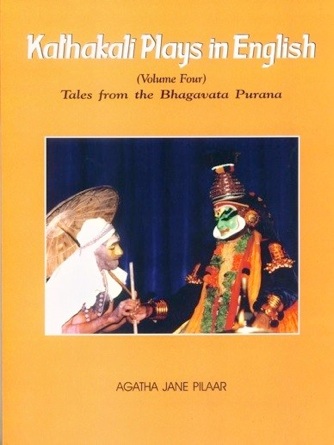Kathakali Plays In English
Volume 4: Tales from the Bhagavata Purana
Kathakali Plays In English
Volume 4: Tales from the Bhagavata Purana

For the librettos for the Kathakali plays based on episodes in the life of Lord Krishna my collaborator/translators were Killimangalam Vasudevan Namboodiripad, already-retired Supervisor at Kerala Kalamandalam when we worked together in 1990-1994 on Rugmini Swayamvara (The Marriage of Rugmini), Subhadra Harana (The Elopement of Subhadra), Narakasura Vadha (The Slaying of Narakasura) and Santana Gopala (Krishna and the Children); and Dr. Prabodhachandran Nayar, Head of the Linguistics Department at the University of Kerala in 1998-2002 when we worked together on Poothana Moksha (The Salvation of Poothana), Bana Yuddha (Bana’s Battle) and Kuchela Vritta (The Life-Story of Kuchela). All these plays were written in the 18th or 19th Centuries except, perhaps, Kuchela Vritta, whose author lived until 1914.
For the play featuring Narasimha, Prahlada Charita (The Story of Prahlada), written in the late 19th Century, my collaborator/translator was Ettumanoor Kannan, Kathakali artist and teacher, composer and scholar, who received his Ph.D in Theatre Arts from the University of Kerala’s International Centre for Kerala Studies in 2012. Kannan also worked with me on Kacha Devayani, a frequently-performed excerpt from the longer play, Devayani Swayamvara (The Marriage of Devayani), written in the 19th Century, and Harischandra Charita (The Story of Harischandra), written in the late 19th or perhaps the early 20th Century. Both stories are to be found in very ancient puranas, and Kannan made use of the two-volume Malayalam works edited by K. Gopala Pillai, Attakkathakal for 56 Nights and Attakkathakal for 63 Nights, published by Sri Rama Vilasam Press, Quilon, Kerala circa 1950. Our work together spanned the long period between 1992 and 2002.
I have included the briefest of plot summaries for two 19th-Century plays which appear in David Bolland’s Guide to Kathakali: Kamsa Vadha (The Slaying of Kamsa) and Guru Dakshina (God’s Gift to the Guru). Although I have seen both about three times in 25 years, I did not deem it useful to make English versions of these plays because they are very seldom performed today.
In addition to my Foreword to Volume 4 and a reprint of my Preface to Volume 2 (Partial), I have included a brief exposition of the Bhagavata Purana by David Bolland, reprinted with his kind permission, as are his short synopses of all the plays of Volume 4.
Also included in this volume--although it should have been in Volume 1--is a brief description/commentary about two items of music and pure dance, the Purappad and the Melappadam, which are unrelated to the Kathakali plays being performed and are presented before the plays begin at almost every performance. This is called “Preliminaries to the Main Play(s)” (see page xviii), and the sung portion of these preliminaries was translated for me by Ettumanoor Kannan. I would recommend that anyone going to a Kathakali performance read this section first, so he/she can better appreciate the first hour of the performance.
Colour photos from the front and back covers illustrate five character types (thereby completing the illustrations in colour of the costumes and make-up for all the archetypal characters of Kathakali), and there are black-and-white action photos at the end of each play, where space permits.
All Photos & Text Copyright 2022 by Agatha Jane Pilaar